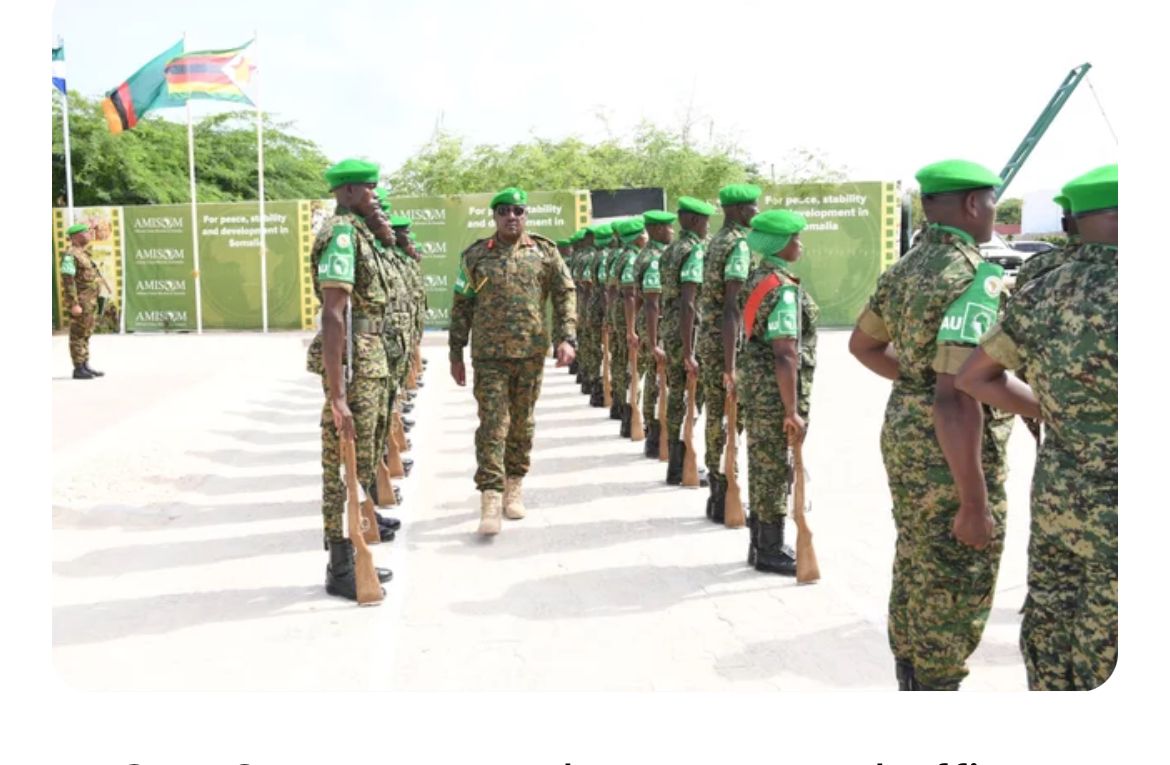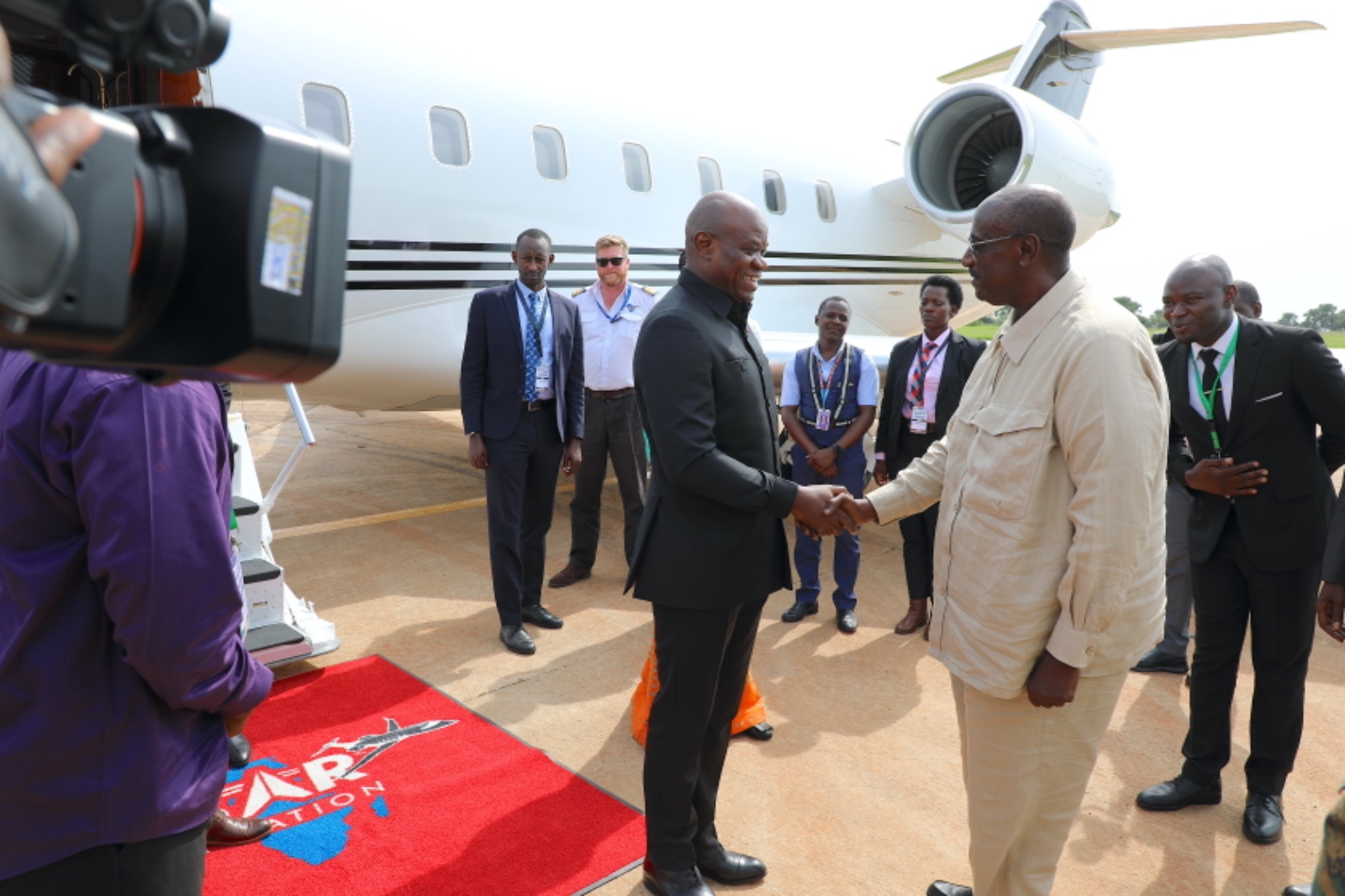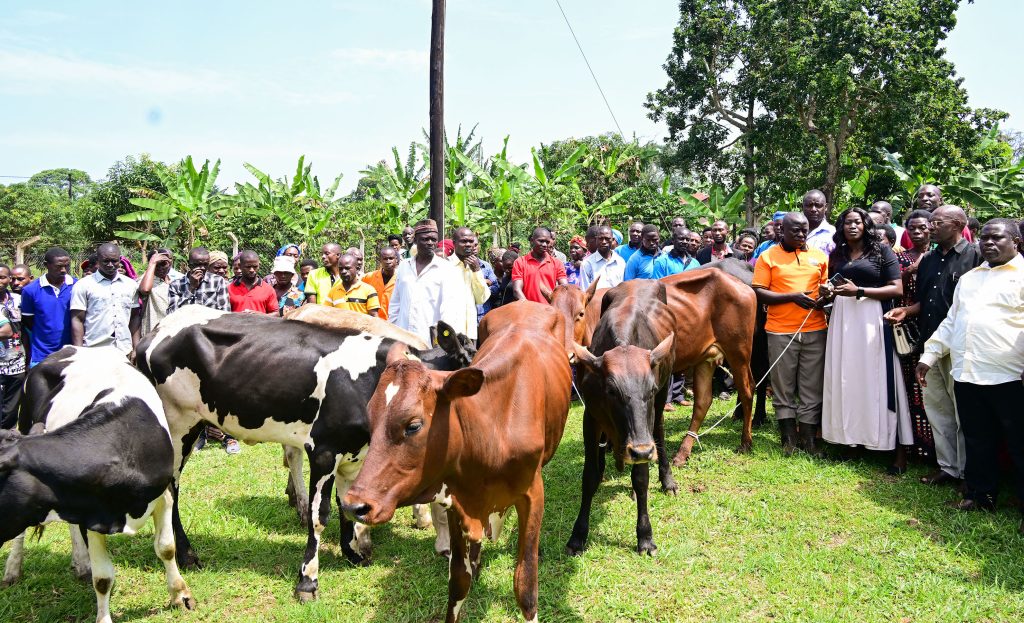More News
.jpg)
Operation Wealth Creation Gets New Leadership

Gen. Salim Saleh and Sky bridge Tactical Agree To Advance National Progress

Lt Gen Sam Kavuma has assumed a new office

THE PRESIDENT OF GABON VISITS UGANDA



President Museveni Meets Ghetto SACCO Leaders, Fulfils Shs1.2 Billion Pledge
President Museveni tasked the ghetto youths to advocate for the interests of the masses like free education for all and prosperity for all as well as embracing government poverty alleviation like the Parish Development Model (PDM) to uplift their livelihoods.
President Yoweri Kaguta Museveni yesterday 31st July 2024 met the leaders of the ghetto SACCOs in Kampala Metropolitan Area at State House Entebbe.
The group included 100 ghetto youth leaders who are also the heads of the 12 ghetto SACCOs in Kampala, Wakiso and Mukono. The beneficiaries of the SACCOs are from; Rubaga Kakeeka Zone dwellers, Kasangati Ghetto Community, Kampala Central Division, Nakawa Division, Makindye East, Kawempe South, Makindye west, Kawempe North, Mukono industrial, Kasokoso, Nansana division and Masajja Para Zone ghetto in Makindye.
During the meeting, the President underscored the role of the ghetto people in the liberation of Uganda.
“What you call ghetto people, in the 1950s used to be called “Abawejere” and they were centred around Katwe. When Uganda was fighting for Independence, much of the activities were around Katwe and I think the first offices of the Uganda National Congress were located in Katwe and that is where I think Dr. I.K Musazi and Dr. Barnabas Kunuka and others operated from. Even Augustino Kamya who organised the boycott of Indian goods in 1958 was from Katwe,” the President said.
“I linked up with the ghetto in 1968. I was there, Katwe is my place. I was not a ghetto boy myself; my background is in the villages with farmers. That is where I came from to go to university, but we (Student movement) wanted to link up with the “Bawejere”. The Head of the abawejere that time was Abbas Kibazo whom they used to call “Ssabawejere” so I linked up with them. So, this story of saying this is my first time to link up with the ghetto is not true,” he added.
President Museveni explained that when former President Idi Amin announced his coup on the 25th of January, 1971, the former students together with the help of the Abawejere decided to fight him because they believed in solving the problems of the people.
“We had and still have a program of the prosperity of the people and Idi Amin could not understand that. Of course, we had problems with Obote, but we were at least able to talk to him. That is why we had not taken the route for fighting. On the 27th of January 1971, I left to fight Amin, so he ruled me for only 2 days. I left with two people from Kampala; Abbas Kibazo and Zubair Bakari and when we went to Mbarara, the people there added some other two chiefs. The five of us entered Tanzania where we met Mwalimu Nyerere and that’s how the fight against Idi Amin started. All the time when we were fighting Idi Amin, I used to come to Kampala and my contacts were mainly these bawejere,” he said.
“In 1971, we also recruited Ahmed Seguya who was from Katwe. He was among the 14 fighters I sent to Mozambique for training. When we went for the second battle in 1981 to fight Obote, Ahmed Seguya was our first army Commander but he died due to liver problems. Amin used to emphasise politics of identity based on religion saying he was fighting for Islam yet there was nothing he was doing for Muslims and other people also. During that time when I used to come to Kampala, I used to stay with my bawejere contacts who were mainly Muslims.”
The President further assured the ghetto youths that the National Resistance Movement (NRM) government is pro- people that emphasises politics of interest and works for all Ugandans.
President Museveni also rallied the ghetto youths to hold their leaders accountable and demand what is meant for them.
According to the President, the problem of the ghetto people started when the educated people (elite) failed to deal with the uneducated although also the uneducated have had their weaknesses like the failure to hold their elected leaders accountable.
He said on top of the government workers like the chiefs who existed during the time of the British (colonialism), when the NRM government came to power, they decided to add on leaders elected by the people from Local Council 1 up to LC.5 (district level) including a woman member of parliament for each district to fill the gap in case the government chiefs failed to perform their roles.
“When we were preparing, I said, you people, to defend the people, we must add another structure, these ones should be elected by the people themselves so that the people’s delegates are there to monitor and hold the government accountable. That is why we created the LCs and MPs to be elected by you people. As people who have power in your hands, why do you go on to elect useless people?” he wondered.
“But also, the wananchi, including the ghetto people, don’t use the weapon which we gave you to deal with the people who don’t work for you. The gun we gave you is that of electing the people who speaks for you if they don’t speak for you, bring them back. We removed the monopoly of power from the administrators and gave you the power to vote your own leaders who speak for you. They even join corruption, and you don’t follow them up. Why don’t you bother to find out? If we bring programs and you don’t follow them, whom do you blame?” he inquired.
On the other hand, President Museveni tasked the ghetto youths to advocate for the interests of the masses like free education for all and prosperity for all as well as embracing government poverty alleviation like the Paris Development Model (PDM) to uplift their livelihoods.
“It’s good now that we have the group of Ddamulira which has linked up with you again, then we will be able to guide you on how to defend the interests of the masses. This is your country and home, you should defend it, you shouldn’t get involved in criminality like illegal protests,” he said.
“In 1997, we launched UPE; education for all in government schools but the people you elect have paralyzed that effort on the ground by always putting charges and other excuses, but you don’t even talk about it. Now get moving, we are already sending all this money; the PDM, Emyooga and now we are adding on something else, and this is just the beginning.”
Furthermore, the President cautioned the ghetto youths against being used by politicians with selfish motives who always land them into criminality.
President Museveni also fulfilled his Shs1.2 billion pledge to the 12 ghetto SACCOs (Shs100 million each) in Kampala Metropolitan Area which he had promised to give them during a meeting at Kololo Independence Grounds last year.
“From the Shs100 million you can do something for yourselves. In the villages, we’re encouraging people into commercial farming. It’s good that you have a base here in the town where you have small businesses, artisanship, services like salons and others. Those are areas you should participate in within your groups (constituencies),” the President told the youths.
The Minister of Kampala Capital City and Metropolitan Affairs, Hajjat Minsa Kabanda thanked President Museveni for the support towards the ghetto people, a manifest that they are part and parcel of Uganda and contribute toward the development of Uganda.
“These people have been trained on how to manage their SACCOs and we are very sure that most of them are now transformed. Those who are yet to transform, will also be transformed,” Hajjat Kabanda said.
The Director of Crime Intelligence and project coordinator, Brig Gen. Christopher Ddamulira said the ghetto project started under the guidance of President Museveni in March 2022 and he has been working on it with his team under the leadership of the Minister for Kampala Capital City and Metropolitan Affairs, Hajjat Minsa Kabanda and the State House Comptroller, Ms. Jane Barekye.
“Previously, these ghetto youth did not have leadership but one thing which we did was to create leadership from the youth themselves, so we conducted elections through which we got leaders at zone, parish and division level.”
He added that the structure was launched by the Minister of Internal Affairs in August 2022 at Lugogo Indoor Stadium and upon the launch, they started on the process of organising the youths into SACCOs because they noticed that previously a number of people would lobby from the government for the ghetto youths, get resources, which never reach the intended recipients.
“What we did was to form the SACCOs and started training the leaders of those SACCOs on how to manage them and then we carried out the mobilisation to ensure that the members themselves begin to save under those SACCOs. Your Excellency, after you launched them, we went into a super drive and as I speak now, we are talking about 3,280 savers in the 12 SACCOs and before you make available resources that you are going to provide today, the youths on their own had reached Shs13.7m from their own savings. We thank you for fulfilling the pledge that you made to them in Kololo last year,” Brig. Gen. Ddamulira said.
Brig. Gen. Ddamulira further noted that the intervention has started yielding fruits by tremendously reducing criminality in Kampala, Wakiso and Mukono.
“Even if you look at the Police report that we issue every year, the last report clearly indicated that the crime level has gone down but also in political violence, these are the people that the politicians have always used to cause confusion in Kampala because they felt they didn’t have a stake in what’s happening in the country. All those crimes have reduced Your Excellency, even recently during the planned march to Parliament, we didn’t register a singer ghetto youth getting involved in those things,” he asserted.
“Your Excellency, we believe that this project is working very well, and your support will go a long way by making the resources they have been lacking available and we embark on so many projects that we couldn’t implement because of the limitation of funding.”
Mr. Kalyango Shafik, the leader of the ghetto youths, expressed gratitude to President Museveni for empowering the ghetto people through financial and moral support.
He also thanked President Museveni for fulfilling his promise of Shs1.2 billion contribution to their ghetto SACCOs.
“Your Excellency, we have evidence that the money reached our bank accounts,” he said.
“We also thank Gen. Ddamulira, Maj. Emma Kutesa, Hajjat Minsa Kabanda and their team for the support and care towards the ghetto people.”
Mr. Kalyango also assured the President that they are now reformed citizens looking forward to working with the government for the socio-economic transformation of the country.
Ms. Nakalema Jackie who is the Vice Chairperson of ghetto youths in Kampala metropolitan Area asked President Museveni to consider them in the PDM program as a special group, saying they have been denied the chance because of their way of living with a perception that they don’t have the capacity to refund the money. The President promised to instruct the secretariat of Emyooga and PDM to consider the ghetto structure.
The meeting was also attended by the State House Comptroller, Ms. Jane Barekye, Maj. Emma Kutesa, the Private Secretary to H.E the President for youth, in agriculture, value addition and export promotion, Dr.Hillary Musoke Kisanja and Nansana Deputy RDC, Mr. Shafiq Ali Nsubuga.
